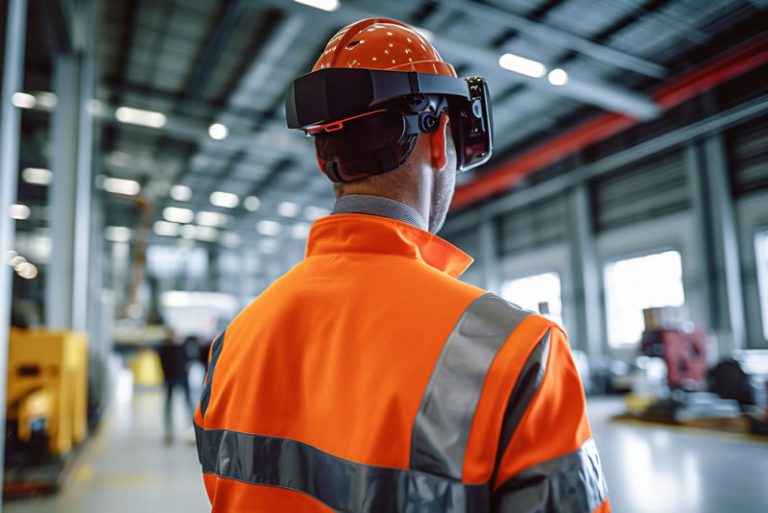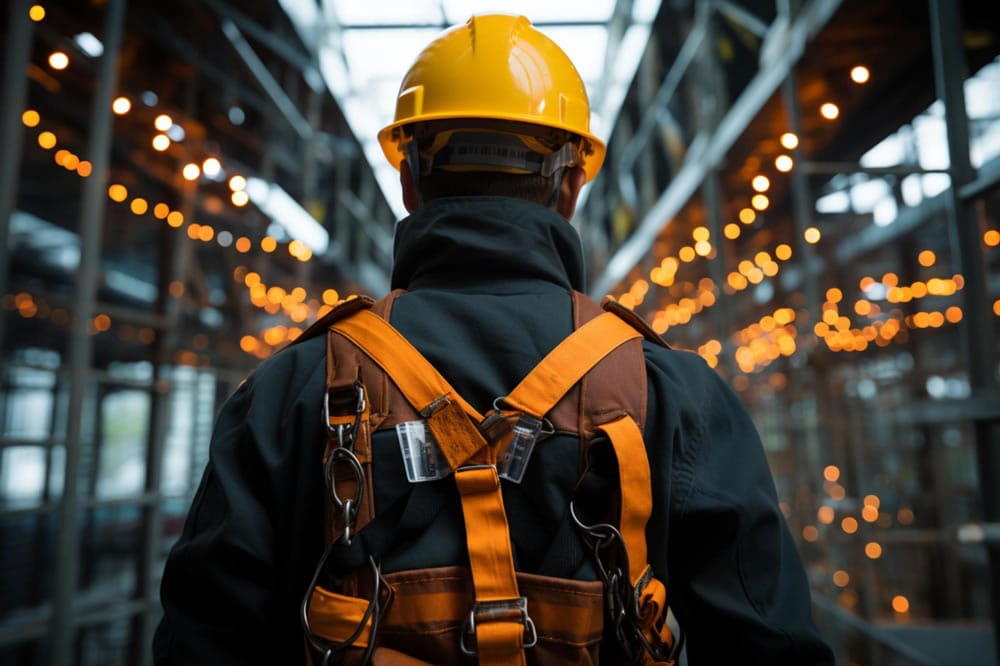In today’s dynamic work environments, ensuring health and safety at work is critical for every organisation. With the evolving landscape of regulations and the increasing complexity of workplace hazards, safety leaders must stay ahead of the curve to protect their workforce and maintain compliance.
Now, let’s review the latest innovations in health and safety at work, from AI to Safety Management Software. And we will explore how technology is revolutionising safety management and safeguarding employees.
But before we start exploring these technologies, a brief retrospective on the evolution of Health and Safety at Work Regulations would provide valuable context.

A Brief History of Health and Safety at Work Regulations in the UK and Ireland
The evolution of health and safety regulations in the UK and Ireland has been shaped by mostly historical major events. In addition, societal changes and the need to protect workers from occupational hazards have had impact on this.
Initially, health and safety legislation in the UK can be traced back to the Health and Safety at Work etc. Act 1974, which established a framework for ensuring the health, safety, and welfare of employees at work.
The equivalent legislation in Ireland is the Safety, Health and Welfare at Work Act 2005. Similar to the UK’s legislation, the Safety, Health and Welfare at Work Act 2005 places duties on employers to ensure the safety, health, and welfare of their employees.
Over the years, regulatory bodies such as the Health and Safety Executive (HSE) in the UK and the Health and Safety Authority (HSA) in Ireland have played pivotal roles in enforcing safety standards. Subsequently, they have promoted best practices across industries.
Alongside domestic regulations, the UK and Ireland also adhere to international standards and conventions aimed at promoting health and safety at work.
These include conventions established by the International Labour Organization (ILO) and directives issued by the European Union (EU). These frameworks set minimum standards for workplace safety and provide guidelines for member states to follow.
Foundations of Health and Safety at Work
At its core, health and safety at work encompass a range of practises aimed at preventing workplace accidents, injuries, and illnesses.
Here are some key aspects:
Risk Assessment: Identifying potential hazards and assessing the risks associated with work activities is fundamental to managing health and safety. This involves evaluating factors such as machinery, chemicals, manual handling, and workplace layout to determine potential sources of harm.
Hazard Control: Once hazards have been identified, measures must be implemented to control or mitigate the risks. This may involve engineering controls (e.g., machine guards), administrative controls (e.g., safe work procedures), and personal protective equipment (PPE) to minimise exposure to hazards.
Training and Information: Providing adequate training and information to employees is essential for ensuring they understand the risks associated with their work and how to work safely. This includes training on equipment operation, emergency procedures, and the use of PPE.
Consultation and Participation: Involving employees in health and safety decision-making encourages ownership of safety responsibilities. Regular consultation with employees, encouraging them to share safety observations allows for a safer work environment.
Regulatory Compliance: Compliance with relevant health and safety legislation, regulations, and standards is a legal requirement for employers. This includes implementing industry best practices.
Implementing effective health and safety at work practices creates a safer and healthier work environment. In addition, this leads to improved productivity, lower downtime, and enhanced employee well-being.
Latest Innovations in Health and Safety at Work
Some of the latest advancements in technology is revolutionising health and safety at work practices. By embracing these advancements, organisations can reduce friction when managing their safety, stay ahead of emerging risks and comply with regulatory requirements.
 One of the main challenges voiced by leaders in the industry is “Human Behavior.“
One of the main challenges voiced by leaders in the industry is “Human Behavior.“
The latest innovations we’re about to explore are tailored to address the challenge of “Human Behaviour”, providing solutions crafted with people at the forefront. This human-centric approach is crucial. These technologies can only truly benefit when designed with user adaptability in mind, aiming to minimise friction and help navigate complexities.
Here's how technology can help
The Role of Wearable Technology
Wearable technology is revolutionising health and safety at work by providing real-time monitoring and feedback to employees. Devices such as smart helmets, safety glasses, and wearable sensors can detect potential hazards. Typically these hazards are falls, exposure to harmful substances, or excessive noise levels. By alerting workers to dangers and providing immediate assistance in emergencies, wearable technology is helping to prevent accidents and injuries.
Security Cameras
Security cameras play a pivotal role in safeguarding workplace environments. With constant surveillance, these cameras serve as vigilant guardians, promptly identifying potential safety hazards before they escalate into harm for employees or public.
For instance, strategically positioned in high-risk zones like production lines or construction sites, security cameras can scan for any signs of danger that may compromise safety.
 Camera footages should regularly be reviewed and monitored.
Camera footages should regularly be reviewed and monitored.
It’s crucial to not only rely on notified incidents but also regularly review and monitor footages for this approach to be truly effective.
Virtual Reality (VR) Training
On the other side, VR training is transforming the way you can train your workforce. By simulating hazardous scenarios in a virtual environment, employees can undergo realistic training without exposing themselves to actual risks.
 VR training shouldn’t merely be used for watching a training video in a virtual setting.
VR training shouldn’t merely be used for watching a training video in a virtual setting.
It’s important that VR training shouldn’t merely be used for watching a training video in a virtual setting, as this undermines its true purpose. Its optimal use is in simulating high-risk scenarios such as working at heights or in confined spaces. By experiencing these situations virtually, workers can effectively prepare for real-world challenges.
Watch out for innovations in AI, Drones and Safety Management Software
Artificial Intelligence (AI)
AI increasingly featuring within many jobs, moving into professional work, legal and health and safety. AI-powered systems can analyse data to help you identify patterns, trends, and anomalies related to workplace safety. Consequently, machine learning algorithms can predict potential hazards, recommend preventive measures, and optimise safety protocols based on historical data and real-time inputs.
Predictive Analytics
Predictive analytics is improving safety management by using data-driven insights to anticipate and prevent accidents before they occur. By analysing historical safety data, and near-misses, you can identify trends and patterns that signal potential risks. This proactive approach to safety management helps you avoid costly accidents and protect their workforce more effectively.
Drones
Moreover, drones equipped with cameras, sensors, and thermal imaging technology are used for aerial inspections of worksites, monitoring of remote or hazardous areas. They provide a safer alternative to traditional inspection methods, allowing for quick and accurate assessment of inaccessible or dangerous locations.
Innovations in Safety Management Software
One of the most significant advancements in health and safety management is the emergence of safety management software. Increasingly, safety leaders are leveraging these digital solutions that offer a comprehensive platform for managing risk assessments to incident reporting and audits.
However, despite the clear benefits, many organisations have yet to fully embrace technology in their health and safety management practices. Instead, they continue to rely on outdated methods such as Excel sheets or paper documents for important safety tasks.
By using the power of technology, you can now streamline your safety management practices and enhance your ability to identify and mitigate risks.
How Safety Management Software Can Help You
At a glance, you have a legal duty, under the Health and Safety at Work Act 1974, to protect your employees’ health and safety. While a health and safety management system isn’t mandatory, it’s incredibly helpful for meeting your legal obligations.
By using a health and safety management system, you can work more efficiently. It helps you spot hazards and fix them faster. Plus, it makes it easier for you to provide evidence that you follow regulations.
Overall, safety management software provides you with a centralised platform to track and manage safety-related data in real-time.
For example, in the manufacturing industry, safety management software can facilitate proactive risk assessments, track equipment maintenance schedules, and monitor compliance with regulations.
Similarly, in the construction industry, these tools can streamline safety inspections, manage subcontractor compliance, and improve communication among project teams.
QR Codes can simplify access to safety functions
One of the common ways where safety management software can simplify safety practises is by providing QR code functionality.
 Simplify access to safety functions with QR codes generated from safety management system
Simplify access to safety functions with QR codes generated from safety management system
This can be incredibly useful in enhancing safety management in various ways. Here is some useful examples:
Equipment Tracking: QR codes can be affixed to equipment, machinery, or tools to track their usage, maintenance history, and inspection status. By scanning the QR code with a mobile device, workers can instantly access vital information. Equipment manuals, maintenance schedules, and safety instructions can easily be accessed to ensure that equipment is used correctly and is in optimal condition.
Safety Inspections: By providing inspectors with easy access to digital checklists, inspection forms via QR codes, you can streamline safety inspection processes. Inspectors can scan QR codes placed at different locations or on specific assets to quickly log inspection results.
Training and Education: QR codes placed on safety posters, signage, or training manuals can link directly to instructional videos, online courses, or interactive modules.
Emergency Response: In emergency situations, QR codes can provide critical information and instructions to employees. They can be placed at emergency exits, evacuation routes, or safety stations. And they can provide links to emergency procedures, floor plans, and contact information, enabling quick response actions during crises such as fires, chemical spills, or medical emergencies.
Incident Reporting: By scanning a QR code located at the incident site, employees can access an incident reporting form or digital reporting platform to document details such as the nature of the incident, location, witnesses, and any corrective actions taken.
Looking Ahead
Modern advancements in technology have left no aspect of our lives untouched, and workplace safety is no exception. By integrating and deploying these cutting-edge technologies, you can effectively prevent accidents and prioritise safety above all else.
From the adoption of safety management software to advancements in wearable technology and predictive analytics, safety leaders have a wealth of tools and resources at their disposal to streamline health and safety management at work and safeguard their workforce.
Moreover, staying informed about the latest trends and embracing innovation, safety leaders can lead the charge in revolutionising safety and creating safer workplaces for all.


